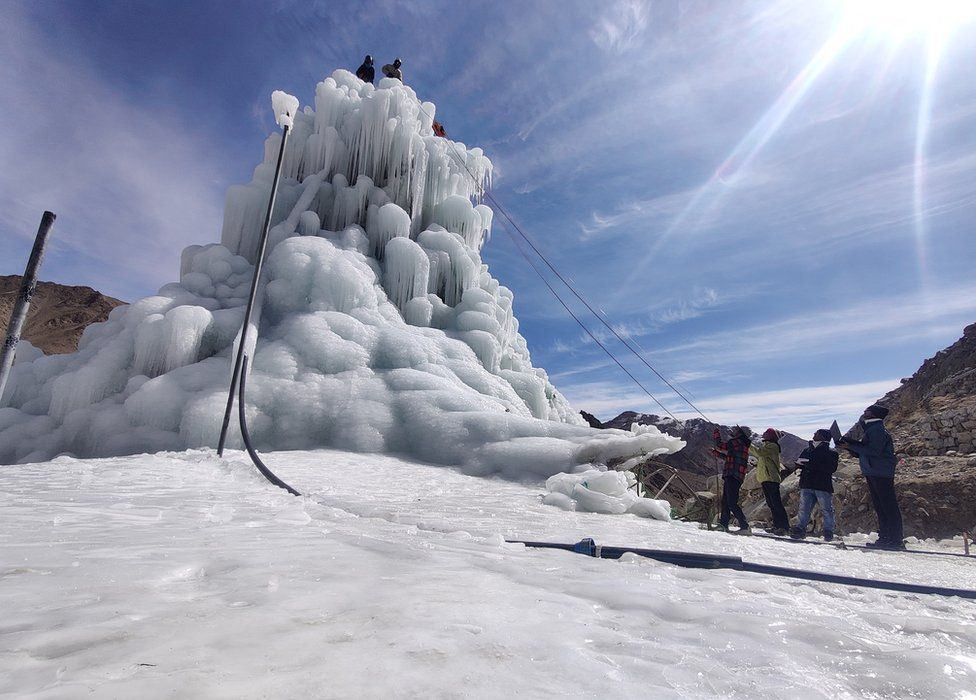
©University of Aberdeen via BBC
Pre-reading questions:
I will read each question. Then, please answer them.
- When is the driest month in your country?
- What was the highest temperature recorded in your country this month?
Vocabulary:
I will read the words, meanings, and sample sentences. Then, repeat after me.
- glacier /GLEY-sher/
- remedy /REM-i-dee/
- frost line /FROST lahyn/
- upright /UHP-rahyt/
- cost-effective /KOST-i-FEK-tiv/
[noun] – a large mass of ice that moves slowly
They built artificial glaciers to solve water shortages.
[noun] – a successful way of curing an illness or dealing with a problem or difficulty
Finding a remedy for unemployment is not easy.
[noun] – the depth to which the groundwater in soil is expected to freeze
Make sure the pipes are placed below the frost line.
[adverb] – vertical and as straight as possible
Despite her injury, she tried to sit upright in bed.
[adjective] – if an activity is cost-effective, it is good value for the amount of money paid
It would be more cost-effective to buy the products in bulk.
Article reading:
Please read the whole article. Then, I will check your pronunciation and intonation.
Scientists from the University of Aberdeen are working on artificial glaciers called ice stupas to help ease the water situation in Ladakh in the Himalayas. The region is one of the driest on the planet, with most villages facing severe water shortages, particularly in April and May. Climate change has worsened the problem, causing natural glaciers to melt. As a remedy, the artificial glaciers are used to store drain water as ice in the winter and then release it as meltwater in the spring. Pipes are buried below the frost line before the final portion stands upright. When pressure rises in the tube, the stream water ultimately rushes up and out of the pipe’s raised tip like a fountain. The water then freezes into a pyramid shape from the ice-cold air.
Engr. Sonam Wangchuk created the ice stupas in 2013, but the glaciers are still in their developing stage. On the other hand, Aberdeen’s Cryosphere and Climate Change research group is improving the technology to use it more widely. “Our research has shown that mountain glaciers in Ladakh are retreating at an increasing rate, so it is clear that interventions such as ice stupas are essential,” said Prof. Matteo Spagnolo from the university team. The artificial glaciers can discharge millions of liters of water each year, and researchers believe that their structure makes them efficient, cost-effective, and simple to administer.
Engr. Sonam Wangchuk created the ice stupas in 2013, but the glaciers are still in their developing stage. On the other hand, Aberdeen’s Cryosphere and Climate Change research group is improving the technology to use it more widely. “Our research has shown that mountain glaciers in Ladakh are retreating at an increasing rate, so it is clear that interventions such as ice stupas are essential,” said Prof. Matteo Spagnolo from the university team. The artificial glaciers can discharge millions of liters of water each year, and researchers believe that their structure makes them efficient, cost-effective, and simple to administer.
Comprehension questions
I will read each question. Then, please answer them based on the article.
- Where is Ladakh located?
- During which months do the villages in Ladakh experience severe water shortages?
- When do the artificial glaciers release meltwater?
- When did Engr. Sonam Wangchuk create the ice stupas?
- What is Aberdeen’s Cryosphere and Climate Change research group currently improving?
Discussion questions
I will read each question. Then, please answer them.
- Has your country experienced a water shortage? Please tell me more about it.
- How do you conserve water?
- What would you do if your water supply got cut?
- In your opinion, will ice stupas be a permanent solution to the water crisis in Ladakh?
- Aside from global warming, what other factors do you think affect or cause a water shortage?